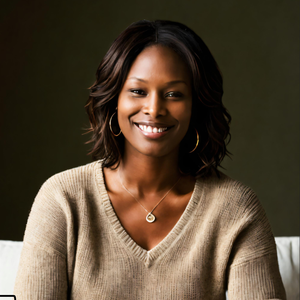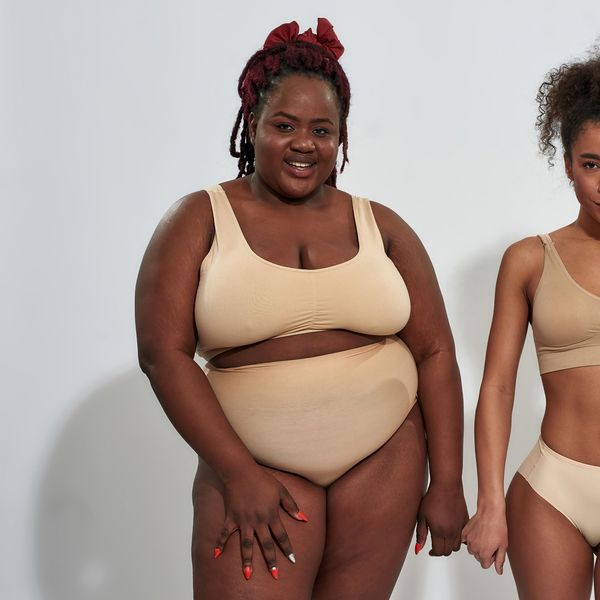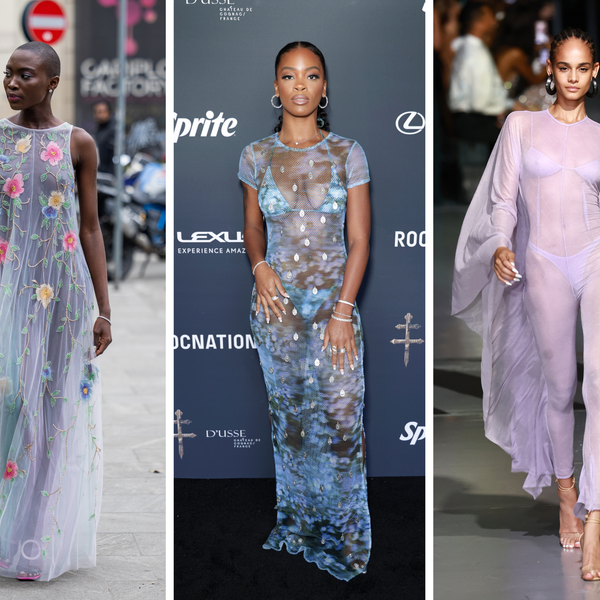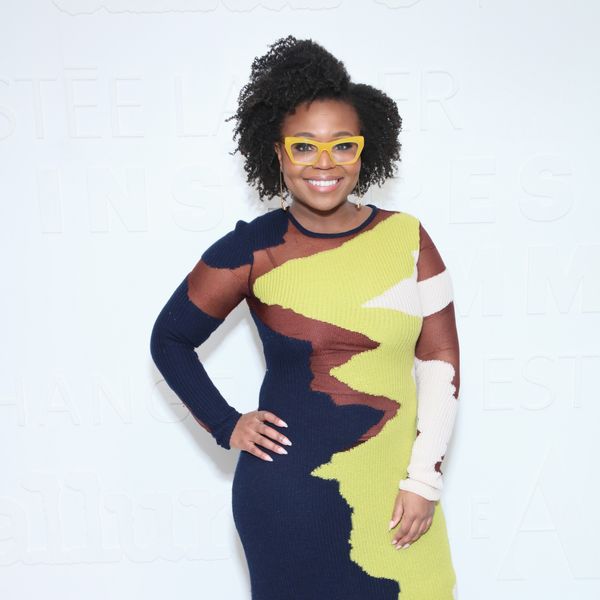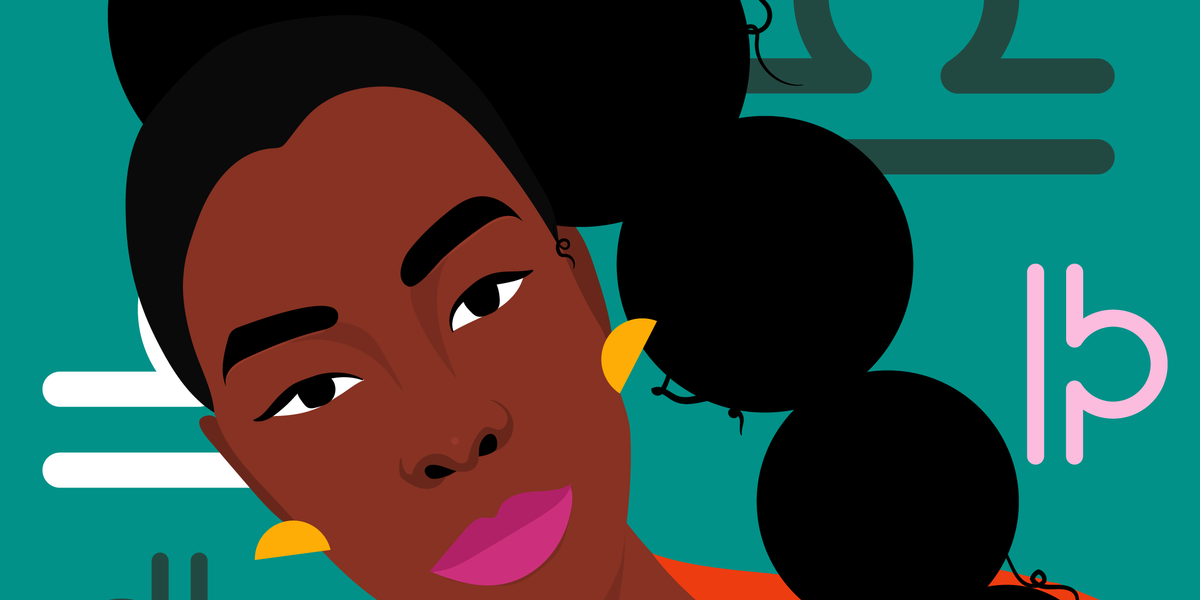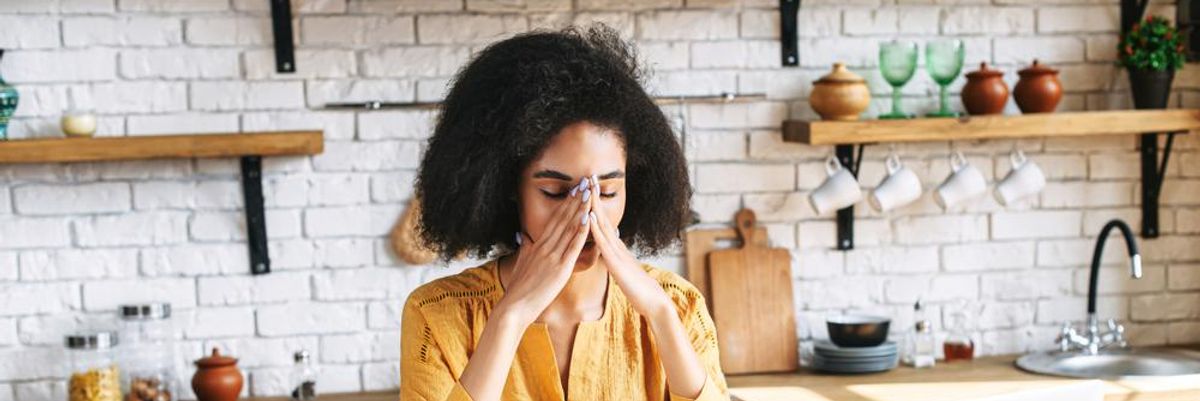Five Ways To Incorporate Neon Into Your Wardrobe As You Ease Your Way Back Outside
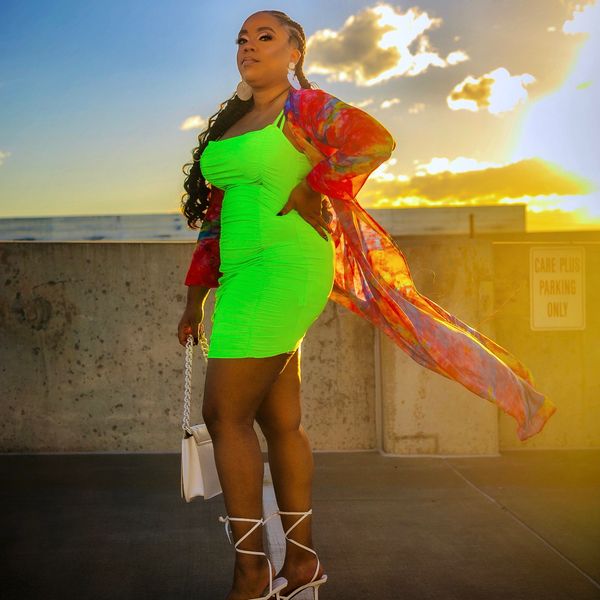
We believe that neon is the perfect way to ease back outside and get your groove back. Shocks of the vibrant tones were seen across spring-summer runways like Christopher John Rodgers and Chromat this past season which means it's time for us to activate neon pieces in our wardrobe. Since the 1980s, neon has reigned supreme as a youthful staple.
This time around, the neon trend life cycle is all about bright green. I have curated five special outfits for y'all that will make your transition outside easy like Sunday morning. What matches a hot summer day better than a neon lewk?
Neon Dress + Kimono + White Accessories

Photography by Curated by Charlie Photography
Bold hues in the form of a ruched dress is what the summer calls for this year. Ruched dresses hug all body types like your favorite auntie. They are welcoming of curves and provide a clean silhouette. Adding a colorful kimono always incites style and beauty, so don't be afraid to use your imagination. To complete the getup, I accessorized with white earrings, a white purse and white kitten heels for major contrast. Don't sleep on kitten heels, sis, they are one of the trendiest pairs of shoes you can don. I wore this on a socially distanced date and my potential bae kept complimenting my style.
Shop a Similar Look:
Neon Sweater Co-ord Set

Photography by Curated by Charlie Photography
I felt so sexy in this short sweater set I wanted to start the 'Hot Girl Summer Reloaded' campaign. I am also starting the 'Make Real Bodies a Thing Again' campaign but we can talk about that later. The bright tone of the coordinate set pairs well with melanin skin but then again we look good in every color. For footwear, I opted for PVC shoes because they are all the rage and they partnered flawlessly with this outfit. The chrome and gold circle handle bag gave it more personality.
Neon Tee + Flared Jeans

Photography by Curated by Charlie Photography
A simple tee can go along way when styled the correctly. Take this look for example. I couldn't wait to throw on this neon GOD IS DOPE tee, so I coupled it with my favorite flared jeans and a bamboo bag. It's perfectly fun and flirty with the loose fit of the top and the shapely fit of the jeans. The vibe is 70s, but the mood is forever.
Shop a Similar Look:
Tie Dye Matching Set

Photography by Curated by Charlie Photography
One time for the undefeated matching set – between dependability and versatility they make my life easier. Then there's the tie-dye trend that may have replaced our obsession with florals. Some call it a comeback trend but we call it a happy pattern that will never go out of style. Over quarantine, it has become a rainbow sherbert dream if you will. Much like my number, it is perfect for lounging sets. You can also find it styles like dresses, purses, shoes and more. For me, tie dye is reminiscent of simpler times and makes me feel like a kid again. Shop the top and bottoms I'm wearing in the photo, here and here.
Neon Sports Bra + Neon-Lined Leggings

Photography by Curated by Charlie Photography
Living in Colorado has forced me to level up my workout gear. I found this set at Walmart and I fell in love with the colorway instantly. Big Rona also made workout gear more appealing now that my living room also serves as a gym. Try adding some color to your gear with your top, leggings and even your sneakers. You will turn heads on your daily run or even as you walk past your mirror.
Want more stories like this? Sign up for our newsletter here to receive our latest articles and news straight to your inbox.
Featured image by Joce Blake for xoNecole / All Photography by Curated by Charlie Photography
Your October 2025 Monthly Horoscopes Are All About Magnetic Love & Divine Timing
October is about the power of attraction. This is the month to set your intentions, create space for a new beginning, and find your balance between the past, present, and future. There aren’t many astrological transits this month, signaling more possibilities in the air and an opportunity to create that which you desire.
We begin the month in Libra Season, and Libra Season is always the time of year when love is the highlight. With Juno also entering Sagittarius on October 1, right as we begin the month, it’s about committing yourself to a new adventure, to the gifts of love, and to perspectives that heal and bring you closer to another.
October 2025 Astrology: An Overview
Mercury enters Scorpio on October 6, and Mercury in Scorpio only knows depth. The conversations being had this month are inspiring, transformative, and a little more blunt than usual. This energy is good for the power of persuasion and for asking for what you want, especially within business and financial matters. On the same day, we have a Supermoon in Aries, and this is a powerful Full Moon for reflection, owning your power, and letting go of the insecurities that don’t resonate with what you want for yourself and your future.
Venus, the planet of love, moves into Libra on October 13 after being in Virgo for the past month, and after some time of healing and clarity in love, Libra is here to bring in the romance. Venus loves being in Libra, and this energy creates new beginnings within relationships and provides a little extra magic in this area of life. With Pluto going direct in Aquarius on the same day after being retrograde since May, life and love move forward mid-October, helping provide more stable and nurturing foundations in your personal life and community as well.
The New Moon of the month occurs in Libra on October 21, making it a beautiful time for manifesting romance, balance, and harmony in your world.
This New Moon aligns with the Sun in Libra, and it’s all about letting a new beginning transform your world and the love in your life for the better. Scorpio Season officially begins on October 22, and Neptune retrograde enters Pisces on the same day, bringing in some water sign energy into the mix. As we close out the month, it’s time to renew, honor the transformations occurring, and know that your dreams aren’t as far out of reach as they may seem at times.
Read for your sun and rising sign below to see what October 2025 has in store for you.
What October 2025 Has In Store For Your Zodiac Sign
ARIES
 AriesKyra Jay for xoNecole
AriesKyra Jay for xoNecoleOctober is all about perspective, Aries. This is the month to trust the divine timing of your life, and not let the what-ifs overwhelm you. With the Sun in Libra, your sister sign, for most of the month, October is about building connections, finding your balance in love, and knowing that you are worthy of what your heart is seeking right now. We have a Supermoon in your sign on October 6, and emotions are a little heavier this month, but also healing. Give yourself grace, and let go of what isn’t working for you.
Venus is in your house of love from October 13 until November 6, and there is a lot to look forward to when it comes to romance and the relationship dynamics in your life as you move through the month. It’s about being confident in your power of attraction and letting love come to you right now. Before October comes to an end, we have a New Moon in your 7th house of love as well, and with all this energy in your relationship zone, life changes for you in love for the better in October.
TAURUS
 TaurusKyra Jay for xoNecole
TaurusKyra Jay for xoNecoleOctober is a spiritual month for you, Taurus. You are thinking a lot about your next steps ahead, and are getting organized, focused, and aligned. The Supermoon on October 6 is a time of reflection for you, and you are entering the month ready to let go of the past, heal, and create space for something new in your life. This month is all about trusting your intuition and letting your wisdom guide you in your personal growth and evolution.
You are more than where you have been, and this month is a reminder of that.
With Mars in Scorpio and in your 7th house of love all month, you are motivated by the partnerships in your life right now. Your love life and relationships are where the action is for you this month, and you are honoring your passion and direction here. Venus, your planetary ruler, moves into your house of health mid-month and into November, and you are leaving October seeking healthier habits, daily routines, and relationships. Overall, this month is helping you align with your vision.
GEMINI
 GeminiKyra Jay for xoNecole
GeminiKyra Jay for xoNecoleThis month is a fresh start for you, Gemini. Your heart is free, love is beaming, and you are feeling larger than life. This month is about taking a leap of faith in yourself, honoring your confidence in life, and being your biggest advocate. With the Sun in your 5th house of self-expression, romance, and happiness, and with Venus entering this same area of your chart mid-October, there is a lot to look forward to right now, and things are looking up for you.
On October 21, we have a New Moon in a fellow air sign, and this is a good time to set your intentions for creative projects, hobbies, romance, and your overall happiness in life. There are a lot of little moments of magic unfolding for you this month, and this New Moon is one of them. Before October comes to an end, Mercury, your ruling planet, enters Sagittarius, and this brings open communication into your relationships, and you are having lively conversations and insights.
CANCER
 CancerKyra Jay for xoNecole
CancerKyra Jay for xoNecoleThis is a transformative month for you, Cancer. You are moving through closure, healing, and depth as you navigate the opportunities that are coming into your life, with the stability you are seeking. With the Sun in your 4th house of home and family in October, this is the month to spend more time in your safe spaces, connect with your loved ones, and get grounded. You are also more focused on your financial world right now, and this is a good time for building new foundations for yourself and looking at the bigger picture when it comes to your career and life goals.
Mars is in your house of romance and happiness for the entire month, and this is one of the highlights of your life right now. You are passionate about your joy and all the things that light you up inside, and you are protecting your peace and giving more of your energy to your pleasure. Before the month ends, we have a New Moon in Libra, highlighting your home life, and some Cancers may be moving at the end of the month or getting the opportunity to turn a page here. Overall, this is your month to reflect, go within, and make sense of what has been restricting you from feeling stable.
LEO
 LeoKyra Jay for xoNecole
LeoKyra Jay for xoNecoleOctober is about taking things one day at a time and being patient with what is presenting itself to you, Leo. This month, you are getting your ducks in a row and gaining the clarity needed to create a new beginning in your life. The month begins with a Supermoon in a fellow fire sign on October 6, aligning in harmony with you and fueling your need for adventure. You are going over the wisdom you have gained as of late and how it has shifted the way you navigate your life and see the world around you.
On October 13, Pluto goes direct in your 7th house of love, after being retrograde here since May. This is bringing in more balance, empowerment, and passion into your love life, and this is a positive change of energy for you after a time of some power struggles within your relationships. Before the month comes to an end, we have a New Moon in Libra, and this New Moon is the best time to set intentions for clarity, communication, and connection. October is about taking your time with things and knowing that everything is working out in your favor at the end of the day.
VIRGO
 VirgoKyra Jay for xoNecole
VirgoKyra Jay for xoNecoleThis October is about finding your balance, Virgo. There is a lot of energy when it comes to your finances this month, but you may be overworking or overcommitting yourself in the process. Honor the opportunities and responsibilities in your life, but make sure you are equally taking care of your health and prioritizing your time and energy so that you don’t burn out. Venus, the planet of love, is in your sign until October 13; use this energy to your benefit and let things come to you.
You are a magnet for abundance, romance, and support if you allow yourself to receive it.
On October 13, Venus moves into your 2nd house of income, and your relationships are a supportive place for you to lean on right now. Your love life and partnerships are where your financial world is evolving this month, and this is a good time to ask for what you want; you never know what may happen. At the end of the month, Neptune goes retrograde in your sister sign, Pisces, and you are taking a step back and reassessing what love means for you right now. Overall, October is about remembering that you don’t have to do it all alone, Virgo.
LIBRA
 LibraKyra Jay for xoNecole
LibraKyra Jay for xoNecoleLibra Season is here, and it’s your time to shine and thrive! This Libra Season changes everything for you, and October is when you really begin to feel this shift in your life. The Sun is in your sign until October 22, and it’s time to put yourself first. With a Supermoon in Aries as we begin the month as well, you are letting go of any unhealthy attachments or relationship dynamics that take you away from yourself, and are moving into deeper clarity.
On October 13, Venus, your planetary ruler, enters your sign, where it loves to be the most. With Venus in your sign for the rest of the month, love takes on a new tone, and you are feeling more love for yourself and where life is taking you right now. To end the month, we have a New Moon in Libra, and it’s time to set your intentions for where you want life to grow for you over the next year. This is a month of embarking on a new journey of self, and allowing what is inspiring you right now to build your confidence in yourself and your relationships.
SCORPIO
 ScorpioKyra Jay for xoNecole
ScorpioKyra Jay for xoNecoleOctober is about honoring your freedom and your power to decide, Scorpio. A lot is going on for you this month, and you have the passion and energy to see things through. Mercury, the planet of communication, moves into your sign at the beginning of the month on October 6, and this is going to help you get your ideas across, making it a good month for business matters, networking, and getting inspired. With Mars also in your sign for the entire month, life moves forward for you in transformative ways in October, and you are a force to be reckoned with.
On October 13, Venus moves into your house of closure, healing, and endings, and you are ready to close one chapter of love and create space for a new one. You are in a contemplative space when it comes to matters of the heart, and you are ready to let go of any heaviness you have been feeling here. Scorpio Season officially begins on October 22, and you are ready to begin again. This Scorpio Season is about owning your confidence in life while letting go of insecurities or self-doubts that have been getting in the way of that.
SAGITTARIUS
 SagittariusKyra Jay for xoNecole
SagittariusKyra Jay for xoNecoleEverything unfolds for you in a beautiful way this month, Sagittarius. You are flowing well with the energy of October, and life opens up to you. With the Sun in your 11th house of aspirations, dreams, manifestations, and community, you are feeling in balance with your desires and your reality, and are bridging the gap here. This is a month of friendship, believing in your dreams, and creating space for love. With Juno also entering your sign at the beginning of the month until the end of the year, you are attracting soulmates into your life.
On October 6, we have a Supermoon in a fellow fire sign, allowing you some closure in love and a chance at healing. Your heart is feeling renewed, and you are owning your power in creating happiness in your life. Before the month ends, Mercury moves into Sagittarius, where it will be until mid-November, and inspiration is heightened. Pay attention to the guidance you are receiving this month, the conversations you are having, and the light bulb moments that are going off for you right now.
CAPRICORN
 CapricornKyra Jay for xoNecole
CapricornKyra Jay for xoNecoleOctober is about going within and connecting with the guidance of your soul, Capricorn. You are taking more time for yourself this month, and rightly so, as you need time to fully process what has happened so far this year. Pluto goes direct in your 2nd house of income, and this moves things forward when it comes to your earning potential, abundance, and values.
The key this month is in valuing yourself, your perspective, and what you are building in your life right now.
On October 21, we have a New Moon happening in your career zone, and this is a good time to manifest your goals within your professional world. Put yourself out there, show up, and know that you are worthy of success and that your dreams aren’t too big for you. As we close out the month, Mercury moves into your house of closure, even further facilitating your desire for contemplation and alone time this month. Overall, October is about taking care of your mental health, owning your successes, and finding your peace.
AQUARIUS
 AquariusKyra Jay for xoNecole
AquariusKyra Jay for xoNecoleOctober is a new beginning for you in love and in life, Aquarius. Your heart is feeling inspired, and there is a lot to look forward to right now. The Supermoon at the beginning of the month will be occurring in your 3rd house of communication, giving you the answers you have been looking for and helping you close the door on a chapter in your life that left you feeling misunderstood or misdirected. You are ready for a change of pace this month, and you are receiving that as we begin October.
Mid-October, Pluto goes direct in your sign after being retrograde since May, and this is a huge breath of fresh air for you and your path ahead. You may have been a little harder on yourself while Pluto was retrograde this year, and now you feel ready to forgive, move on, and own your power. Before the month comes to an end, we have a New Moon in Libra, and you are embarking on a new adventure. The end of the month is a good time for traveling, exploring, and gaining a new perspective.
PISCES
 PiscesKyra Jay for xoNecole
PiscesKyra Jay for xoNecoleThis month is giving you the guidance, perspective, and passion to see yourself with clear, loving eyes, Pisces. There is a sense of feeling more overwhelmed with life lately, and October is allowing you to gain the insight needed to move on from this energy, or at least see more of the gifts of what has occurred. On October 6, we have a Supermoon in an area of your chart having to do with self-worth, values, and income, and it’s time to see the gifts of what you have been investing in and valuing in your life, including yourself.
Let go of the need to play it small or count yourself out of important conversations, and know that you deserve a seat at the table.
With Pluto going direct in your 12th house of healing as we end the month, you are finally getting the answers you have been looking for emotionally, and it’s changing your perspective on your commitments in life and making you feel empowered. Before the month ends, Neptune goes retrograde in Pisces, and you are going to be moving through a personal revolution as we close out the year. You are inspired by change right now, and this month is what kicks starts this metamorphosis within you.
Let’s make things inbox official! Sign up for the xoNecole newsletter for love, wellness, career, and exclusive content delivered straight to your inbox.
Featured image by Kyra Jay for xoNecole
You Don’t Have To Do It All: Breaking The Cycle Of Overfunctioning
I don't know who needs to hear this, but you are not (and should not be) the end-all, be-all solution to everyone's problems. Burnout is a real issue among women, and it often stems from overcompensating, over-performing, and overextending yourself until you finally give zero F's and become over it.
I recently came across a term that made me do a double-take on my own life: overfunctioning. According to the experts at Psychology Today, overfunctioning happens when you go above and beyond to control a situation and others' perceptions and feelings around it. You try to become the hero who will do anything to make sure that all is well, even if it means putting yourself last or not getting what you truly want.

Image via Giphy
A study found that 70 percent of working women have experienced burnout since the start of the pandemic. In addition to being "Zoomed" to death, women have to deal with household and care-giving responsibilities, educational pursuits, and other commitments that put them in overfunctioning mode.
Here's what overfunctioning looks like:
- Excessive people-pleasing to avoid disappointing others
- Avoiding saying "no"
- Setting goals for other people without their permission
- Taking on more responsibilities even when you are not asked
- Enabling bad behaviors in others
- Always talking and never listening to others
- Giving unsolicited advice
- Feeling like a victim when others do not recognize your efforts
As an overfunctioner, your anxiety is the driver of your actions because in your mind, if you are not in control of everything, something has to go wrong eventually. You may argue that overfunctioning is "just how it is" or "just the way you are," but it's actually a response to anxiety related to things that honestly have nothing to do with you.
Here's the thing: For so long, we've heard the narrative of being a "strong Black woman." We have to be tough, resilient, independent, and ready to take on life without a flinch because that is what we were taught to do. However, we have to be conscious enough to understand when we follow generational or societal trends by default or subscribe to the need to constantly be in control at all times.
Whatever your reason, take time to understand the emotional, physical, and mental toll overfunctioning can take on your life. "Doing the most" gives you an illusion of being in control when, in reality, you are losing control of yourself.

Image via Giphy
If you're overfunctioning, understand this:
- You don't always have to be the bigger person if it's to your own mental and physical detriment.
- You don't always have to give people, work, and situations every bit of your being.
- You don't always have to find a solution just because someone comes to you with a problem.
- You don't always have to be a helicopter wife, girlfriend, parent, or friend, trying to stop others from learning from their own mistakes.
You are ultimately responsible for yourself and how you react and respond to life.
You will find better peace of mind knowing that you can eliminate burnout when you stay and operate within your lane and live a life where you can let your hair down and let others do the same, live life, and learn for themselves.
Let’s make things inbox official! Sign up for the xoNecole newsletter for love, wellness, career, and exclusive content delivered straight to your inbox.
Featured Image via Shutterstock
Originally published May 5, 2021


